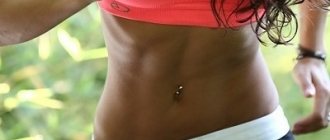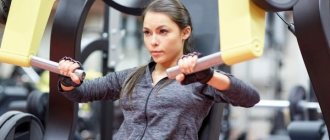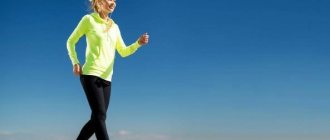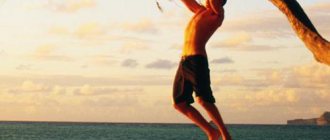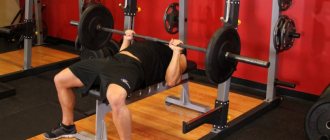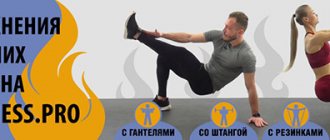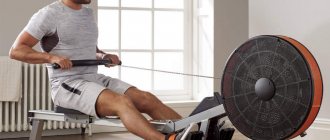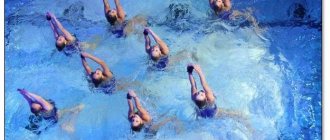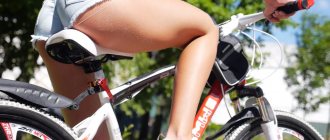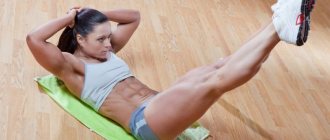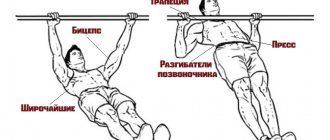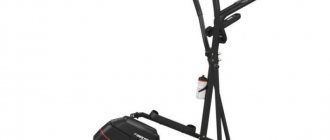Less popular causes of pain
Why do my legs hurt after squats? Among the common reasons, experienced athletes identify the following:
- The action of lactic acid - a product of physiological processes accumulates in the structures of muscle fibers. Usually, leaching of the substance from tissues is observed within 24 hours. The concentration of lactic acid in the body poses absolutely no health hazard.
- The delayed effect of microtraumas of muscle fibers - ruptures of muscle bundles after increased loads are a completely natural process. This is how tissue mass increases. In some cases, the phenomenon provokes increased production of hormones responsible for the removal of toxins and restoration of the body. The consequence is the development of pain.
- Increased muscle reactivity - heavy, uncharacteristic loads for humans lead to an imbalance of biologically active substances in bodily fluids. The result is the occurrence of convulsive conditions.
- Excessive amount of training - legs often hurt after squats, if exercises to pump up local muscles are performed daily. In this case, there is a nitrogen imbalance, the consumption of more protein relative to the amount received.
- A high range of motion - adding variety to a standard exercise - often leads to severe pain in the legs after squats. The result is stress on small muscles, which are rarely used in everyday life. The response is bound to be a feeling of discomfort.
- Trauma to the extremities - the presence of damage will be indicated by the constraining movement, aching nature of the pain. Often the consequence of trouble is the formation of swelling.
- Failure to comply with the correct exercise technique – the feeling of pain is often caused by making mistakes during training and using inappropriate loads.
Also, pain after squats can be caused by the following reasons:
- Lack of vitamins in the body.
- Excess salts.
- Osgood-Schlatter disease.
Training without leg pain after squats - how to achieve success
Do your legs hurt during or after squats? Most often, this problem arises among beginner athletes who are not yet able to regulate the loads and violate the execution technique. However, the causes of pain in the legs may lie in other things. What exactly is the most important thing - how to treat leg pain? More on this below.
So, the knee joint receives the greatest load during squats. That is why he is at risk! The knee joint itself has a complex structure and fragility. It can be damaged not only as a result of a fall, but also by performing exercises incorrectly.
The main causes of leg pain
The reason for pain in the legs after doing squats is, as a rule, a violation of the exercise technique. Knees that are turned to the sides or form an acute angle will cause overload of the joint, which will ultimately cause pain in the legs. Acute pain during squats will also be evidence that the exercise technique is not correct.
The so-called “lumbago” in the knees after performing the exercise is a signal that cannot be ignored! In this case, there will be a high probability that an injury occurred during squats - the ligaments were torn or stretched. The first aid in this case will be complete rest for the leg and dry ice. At the first opportunity, you will need to contact a specialist.
https://youtu.be/GDCWZmoW-cU
Persistent and persistent pain in the legs after a workout that includes squats will be evidence that a chronic disease, such as Osgood-Schlatter, is beginning to develop.
Cases of the disease developing as a consequence of a knee injury during training are quite common.
With proper treatment, the disease can go away in a few weeks and in exceptional cases takes a chronic form.
If your legs hurt after training, and your knees crack during squats, this may be a sign of arthrosis. It is important to start treating diseases in the initial stages, preventing it from becoming chronic!
Excessive stress on your legs can also cause pain after exercise. We are talking about using large weights without prior preparation and special equipment - bandages and an athletic belt.
Additionally, we note that one of the causes of pain in the legs after squats may be an elementary lack of vitamins in the body or an excess of salts. Watch your diet, include in it a complex of vitamins you need.
How to avoid leg pain?
Knee joints, as the main source of pain, are quite fragile and require a specific approach to treatment. That is why it would be correct not to self-medicate, but to promptly seek help from your doctor. There are a number of traditional methods that are used to relieve pain in the legs after exercise. We are talking about the following:
- Milk compresses with bran. Mix milk with bran in a ratio of 1:3 and, moistening a rag in the mixture, you can make compresses for your knees.
- Give your feet a bath after training with infusions of herbs and essential oils.
- Do exercises to treat arthrosis if there are prerequisites for its occurrence.
- If your legs continue to hurt, seek help from a physical therapist who can prescribe a course of treatment.
- Do not be afraid to use special orthopedic patches based on medicinal herbs.
Legs often hurt due to the accumulation of lactic acid in the muscles. Why does this happen and how to get rid of pain? Read about it below.
Execution options
Another reason why your legs hurt after squats is improper execution of the exercises. The problem especially often arises among those who train independently, and not under the guidance of a trainer. It would seem that squats are the simplest exercise, what can you do wrong?
Squats can be performed with various weights - a barbell, a kettlebell, dumbbells, a ball, or in exercise machines. But in order to achieve the maximum effect from the exercise and not harm the body through injury, it is necessary to work out the exact technique of the exercise without weight, only then move on to more complex loads.
For the exercise to bring maximum benefit, it requires proper technique at each stage of execution.
Initial position
- place your feet as wide as possible, toes should point outward;
- fix the vertical position of the body so that it does not lean forward and the shoulders are not rounded.
- Hand position is not of primary importance. Your arms can be kept on your sides or extended in front of you.
Movement
- as you inhale, move down and count 1, 2 and 3 until your thighs are parallel to the floor or go down a little deeper;
- hold at the bottom point for a few seconds and feel how the muscles tense and stretch;
- as you exhale, return to the starting position, fully straightening your knee joints and straightening your legs;
Proceed immediately to the next rep. No pause is required between approaches.
Important details!
- During all approaches, you need to look at a distant imaginary point located above eye level. This technique allows you to control the correct location of the housing. The back should be perfectly flat, and a slight deflection should be maintained in the lumbar region.
- Performing plie requires the correct position of the knees, that is, similar to that followed in the classic version, so that the kneecaps do not extend beyond the line of the toes.
- To maintain tension in the muscle working groups, you should not strain your knee joints. At the top extreme point, the knees should be completely straightened.
- When difficulties arise with balance, the first lessons can be carried out with the use of support, which allows you to consolidate coordination skills.
There are several variations of the wide-foot squat:
- Plie pulse when squatting with a small amplitude. Lower your hips to the horizontal, lift them up quite a bit and repeat again. In this way, the result is consolidated, that is, the target muscles are refined.
- Plie with emphasis on one leg, allowing you to redistribute the load. One leg is placed on the toe, and the other on the foot. This option is ideal for diversifying training and pumping up a specific leg.
- The toe plie is a variation of the exercise for well-coordinated and fit people. Only socks touch the floor. Not only the inner thigh muscles are involved in the work, but also the calves.
- On the calf muscles, when only the heel is lifted alternately from the lowest point. This exercise gives the calves a beautiful and well-developed relief.
- With a jump, when they jump at the top point. This variation has an aerobic component and trains the heart muscle well.
Weak trunk muscles
In addition to the problems listed above, many people underestimate the importance of the core muscles for proper squatting. When you squat, it is important to keep your spine in an upright, neutral position and maintain this position throughout the exercise. If your core muscles are weak, it will be impossible to keep your back straight.
If you cannot fix your torso in an upright position, you will end up with an abnormal forward bend, disrupting the natural arch of the spine. Both problems, as you already know, cause discomfort. In addition, you will have a very difficult time squatting with heavy weights.
Strong core muscles are the key to strong squats!
Water treatments
If your leg muscles hurt after squats, what should you do? Experienced athletes advise taking a contrast shower. The duration of the procedure should be about 10-15 minutes. The solution helps relieve severe discomfort and provide high-quality muscle relaxation after high-intensity training.
A proven solution is to take a warm bath with sea salt dissolved in water. Bath procedures, when warming up the body alternates with dousing with cold water, will allow you to recover more quickly. You can replace these solutions by swimming in a cool pool. In all cases, relief from discomfort is observed due to the expansion of blood vessels.
Massage
In situations where your legs really hurt after squats, a relaxing massage will come to the rescue. You can achieve the desired effect yourself, without resorting to the services of a specialist. The following steps will help you recover:
- The limb is tightly clasped with the palms and held with the hands, moving in the direction from the legs to the hips;
- Point pressure is applied to painful areas;
- The procedure is completed by rubbing the feet over the entire surface.
The best results can be achieved by using massage oils that can produce a warming effect on the tissue. A good solution is to use massage rollers that have a textured surface. Due to the action, blood circulation can be improved in areas of the limbs where discomfort is noted.
Medicinal way to solve the problem
If your legs hurt after squats, you should use a number of ointments, creams, and analgesic tablets. The intensity of discomfort will noticeably decrease due to the application of such products as Troxevasin, Fastum-gel, Voltaren, Finalgon to problem areas.” The action of these drugs is aimed at warming tissues and relieving swelling. Ointments and creams will help increase the elasticity of compressed tissues, activate blood flow, and restore local metabolic processes.
The most effective, safe tablets that can be used to relieve pain in the legs after squats are: Ibuprofen, Aspirin, Nurofen. The indicated medications are non-steroidal in nature. The use of such drugs helps eliminate inflammation, swelling, and reduce the intensity of pain. However, the use of tablets should not become a habit and become the main method of dealing with regularly occurring discomfort.
Arthrosis
If your legs hurt when squatting, and your knees “crunch”, even with the correct exercise technique, the reason may be an incipient joint disease - atherosclerosis. It is important to immediately go to see a doctor . If the disease develops and becomes chronic, it will be very difficult for you to get rid of it and continue to exercise.
Features of symptoms
Pain in the joints when squatting, “crunching” in the knees. Symptoms are disturbing even if the exercise technique is correct.
Treatment methods
To establish a diagnosis, you should consult a doctor - a therapist or orthopedist. The specialist, depending on the nature and degree of development of the disease, will prescribe treatment and give the necessary recommendations.
Introducing an exercise into a training program
We found out which muscles squats are useful for, but don’t rush to start exercising. First, let's talk about whether it's normal to feel pain after every workout.
There is an opinion that painful sensations are the main indicator that you have forced your muscles to work hard. Every jock in the gym has heard the following phrase: “it hurts, it means it grows.” How true is this statement?
There is some truth in it, but there is also just as much nonsense. There are actually 2 types of pain – anabolic and physiological. The first is experienced by athletes who exercise correctly, following the technique, the program, and giving the muscles an adequate load. But they don’t allow the latter to relax.
And the second type of pain is the result of working with excessive weight, neglecting technique, non-compliance with rules, schemes and other important details of correct strength training. As you understand, the result in this case will most likely result in injury.
Remember, muscle pain of a physiological nature (bad) is aching, constraining, and does not allow full movement. Often accompanied by general malaise. Anabolic pain (correct) is moderate, sometimes with a slight tingling or burning sensation, and does not in any way interfere with muscle function. It lasts no more than two days, after which it goes away without a trace.
So, let's summarize all of the above. When squatting, men and women work the quadriceps, gluteus maximus, hip adductor and soleus muscles. The back extensors and abdominal (rectus and oblique) muscles act as stabilizers. Additionally, the leg biceps and calves are involved. As you can see, the entire lower body is working. This is why squats are so beneficial for toning your legs and butt. I wish you successful and pain-free training!
The exercise is a classic variation of squats, which are classified as compound movements involving all the muscles of the lower extremities. The calf muscles, gluteus maximus, femoral muscles, including the bi- and quadriceps muscles, as well as the vastus medialis and sartorius, adductor muscles, take an active part in the work.
To control movements and maintain balance during the exercise, the soleus muscles and stabilizers are involved in the work. The role of the latter is performed by the press with back extensors.
The main difference is the placement of the legs. When performing plie, the feet are wide apart and the toes are turned outward. Changing the position, technique and range of movements allows you to ensure that the load is directed to the inner thighs and gluteal muscles.
Many people mistakenly confuse these two exercises with each other, but this is absolutely not true. When performing sumo, the pelvis is pulled back and the body is moved forward. This technique allows you to use a much larger load in the form of heavy weight.
“Plie” is performed with a strictly vertical position of the body and the pelvis is not pulled back so much. The muscles of the inner thigh are involved in the work. This is a completely different load distribution, so it’s impossible to say that these two squat options are the same.
Wide-legged squats are an effective movement that complements the main exercise complex, which is designed to work and develop the muscles of the legs. They do not replace classic squats and can be included in the training program as a supplement. “Plie” can be used separately if it is necessary to increase and change the direction of the workload, as well as adjust the shape and increase the volume of a certain muscle group. High-quality loading of the target muscle group is accompanied by the development of stabilizing muscles of the abdominal and back muscles.
Varieties of Plie
The calisthenic variant with overcoming one’s own body weight is usually referred to as the “sumo” interpretation. There are many “power” versions that can significantly complicate squats. Such varieties allow you to increase the “press” load. You can use a kettlebell, t-bar, dumbbell, barbell.
Representatives of the fair sex include squats with wide stance in their training. There is a completely reasonable explanation for this, so this choice is due to practicality.
Plie differs from the classic variation in that the movement reduces the pressure that the workload puts on the quadriceps and focuses on problem areas for women, which are quite difficult to work out when performing standard movements. These muscle groups include the gluteal and adductor muscles.
- squats with a wide stance are among the few movements that allow you to load and work the inner thigh muscles, which are hard to reach;
- plie refers to exercises that allow you to work the inner surface of the thigh muscles;
- the knee joints are not overloaded due to the fact that the movement when performing plie is anatomically natural, but this is only true if the correct safety precautions are followed, which reduces the risk of injury;
- the exercise is great even for those athletes who have suffered a back injury, and they can even use weights, which is due to the specifics of the movement and position, which allows them to isolate the spine;
- the movement puts a complex load on a fairly large number of muscles;
- plie squats are well suited for both building and separating muscle mass in the lower part of the body;
- load variability when using different types of projectiles;
- increase elasticity and mobility of the articular-ligamentous apparatus.
Plie squats are suitable for performing both in the gym and at home.
The standard technique of execution is classic, and the use of weights in the form of dumbbells, kettlebells, barbells allows you to complicate the exercise. This is not the only way available to improve the efficiency of the basic movement. You can make squats more difficult by doing the following:
- The deeper you squat, the more load your gluteal muscles receive. How to achieve this? You can use a step platform, plates or plinths placed under each leg. This option is not suitable for everyone. It is recommended for people with high hip flexibility.
- Raising at the top point of the movement, that is, when returning to the starting position. This allows you to pump your ankle and develop your calf muscles even more. This approach to performing the exercise significantly increases the load.
These two options allow you to diversify your workout and further work out hard-to-reach areas of the leg muscles.
Plie squats are basic movements for the gluteal and calf muscles. It is recommended to perform the movement at the beginning of the lesson, but after a good warm-up. It is very useful and perfectly complements lunges or leg presses. The number of repetitions depends not on the level of training, but on whether additional weights are used:
- a large number of repetitions (15-20 times) with load variability, which is entirely determined by the athlete’s own level of training;
- power squats cannot have the same repetition rate and are performed 8-10 repetitions or 10-50 in 4-5 approaches, when the muscles are given relief.
Plie squats can be used as finishing movements to complete a workout. In this variation, they are performed to complete failure, and no weights are used.
In situations where, after squats, the legs and not the buttocks hurt, athletes are advised to resort to cardio exercises. The implementation of the idea makes it possible to saturate the muscles with oxygen. There is an accelerated delivery of nutrients to tissues due to increased blood circulation. Muscles get rid of concentrated lactic acid much faster. The body is freed from all kinds of toxins.
Classics of the genre
It’s best to start the review with a classic exercise that can only be effectively performed in the gym.
Naturally, these are squats with a barbell. The reader will learn which muscles work and how to properly pump them with this exercise only after becoming familiar with the technique. When doing squats, it is important to follow only two rules: always keep your back straight and do not let your knees go past your toes. Everything is simple and accessible - when you squat, you just need to move your pelvis back and squat. After which, having reached parallelism between the line of the hips and the floor, you need to return to the starting position.
https://youtu.be/SXyYG_fGXuM
Now about the working muscles. Many professionals often joke that only those muscles that hurt grow. In fact, this is not entirely true, it’s just that after squats the upper thigh and buttocks hurt. These are the muscles that work in this exercise.
Weights: to use or not?
The use of sports equipment helps the athlete regulate the load level and achieve real training stress. This is a fairly effective and profitable technique, which largely allows you to achieve the goals set for the athlete.
High and peak loads are not suitable for everyone. For some athletes, weights are contraindicated. This applies to people with injuries to the hip and knee joints, spine, and so on. They cannot perform squats using implements.
Myths and reality
Having figured out which muscles work when squatting, it’s time to discuss the effectiveness of the exercises themselves, as well as get acquainted with the recommendations of trainers and reviews of athletes. There are quite a lot of articles in the media that describe the benefits of squats. Readers are assured that only this exercise can force blood to circulate properly in the hip joint, and it is also impossible to lose weight without squats.
Losing weight is even easier. Yes, you can lose weight quickly by doing squats every day. But you can also get rid of excess weight by pumping up your pectoral muscles or back. The trick is that these are the largest muscles in the human body and require a lot of calories to work.
Plie squats according to the rules
In order for the exercise to bring maximum benefit, the following points must be taken into account:
- The legs should be wider than the shoulder girdle, and the toes should be spread to the sides. The direction of the toe sets the vector of movement of the knee joint.
- The knees are directed towards the toes. The left one “looks” to the left, and the right one “looks” to the right.
- The body is fixed strictly vertically, so when moving you must be sure to monitor this moment.
- Plie power squats are performed smoothly and at a slow pace, controlling every movement.
- The gaze should always be straight and the chin raised.
- Returning to the starting position requires “switching off” the knees, that is, they remain bent until the very extreme point.
How to make specific muscles work?
Beginners often perform plie squats incorrectly. They make a number of typical mistakes:
- The knees are moving. During movement, you should not allow your knees to go beyond the line of your toes forward or begin to converge towards the center.
- The heels come off the floor. Feet should be on the surface. The exceptions are squats on one leg and on toes.
- Poor coordination. Performing the exercise against the wall allows you to stabilize the position of the body until the desired result is achieved.
- Back arch. Similar to other squat variations, you need to keep your back straight.
If you initially follow these simple rules, no problems will arise.
Exercise forces all the muscles of the body to work, and also accelerates their growth and strength. The main muscles that perform the functions of torso extension during squats are: quadriceps femoris, gluteal muscles, hip adductors, soleus muscles. Additional stabilizer muscles are the spinal extensors, abdominal muscles, calf muscles, and biceps femoris.
Let's try to figure out what squats pump, which muscles work:
- Target group – quadriceps (quadriceps)
It is located entirely on the front and partially on the lateral surface of the thigh, consists of 4 bundles. Responsible for straightening the leg at the knee.
- Together with the quadriceps in this exercise, the gluteus maximus, hip adductors and soleus work together.
The gluteus maximus is the largest of the 3 gluteals and is located closest to the surface of the butt. It is she who is responsible for the shape and appearance of your butt. The hip adductors tighten to stabilize the pelvis and work to drive the leg toward the midline of the body. Thanks to the soleus muscles, flexion/extension of the foot occurs towards the sole.
Let's continue to study the muscles that work when squatting, and from the main group we will move on to the secondary one.
- The next group is the stabilizer muscles, among which the back extensors, as well as the rectus abdominis and oblique abdominis, are involved when squatting.
The extensors are two thick flaps that are located on either side of the spine from the neck to the pelvis. It is thanks to them that a person can bend over, rotate the body, etc. The rectus abdominis and oblique abdominis are located in the abdominal region. These areas are pumped and trained in order to achieve beautiful abs.
- Dynamic stabilizers - work to maintain balance of different parts of the body while performing an exercise. In squats, this function is performed by the hamstrings and calves.
The biceps femoris (biceps) is located in the back of the thigh, the antagonist of the quadriceps. Thanks to it, we can bend the leg at the knee and rotate the shin. The gastrocnemius muscle is located on the back of the lower leg, extending from the femur to the Achilles tendon. It works so that a person can move the foot, as well as maintain balance while walking, running, etc.
So, now you know what swings during squats in women and men, now let's figure out how to make certain muscles work to a greater extent.
Please note that the main rule applies here, on which not only the effectiveness of the training depends, but also the health of the trainee. Study the squat technique carefully and follow it strictly. Especially if you are going to lift heavy weights.
Let's look at the types of squats and which muscle groups work in each case:
- The quadriceps works almost constantly, and the ideal exercise for its 100% load is the classic squat with a barbell on the shoulders. Front squats (barbell on the chest) give the same effect, but cause less injury to the knees;
- When squats, where the legs are together, the muscles of the lateral and outer surface of the thigh work;
- Conversely, in squats with a wide stance, for example, plie or sumo, the inner surface of the thigh muscles works to a greater extent;
- If an athlete works with dumbbells that are placed in the lowered hands on the sides of the body, the back works harder than usual;
- Hack machine squats allow you to redirect the load to the outer thigh, you just need to place your feet a little wider than usual;
- To engage the upper quadriceps, place the bar directly in front of you on your bent elbows and squat down like this;
- What muscles do you think don't work during the Smith Machine squat? That's right, due to the absence of the need to control your balance, you will practically not use stabilizers. But make the task more difficult for the quadriceps.
Now you know what muscles swing when squatting in girls and boys. In conclusion, let's touch on one more topic.
We train correctly
An experienced sports coach will tell you what to do. When you decide to train on your own, pay attention to a number of points. Careful preparation is required before exercise. If the body is prepared for further stress, the legs will not hurt. To make sports a positive experience, follow these simple recommendations:
- Warming up the muscles with a warm-up;
- Drink water in small sips throughout your workout. The liquid accelerates the removal of broken down molecules that cause pain. During physical activity, the body loses moisture, requiring compensation.
There are many exercises that are often performed incorrectly. One of the most traumatic is the squat. Taking a position that does not comply with the rules, people squat incorrectly, as a result of which they often suffer joint injuries (fractures, dislocations) or long-term muscle pain.
The decision to get involved in sports requires a serious approach. The ideal option is training with a trainer. He will tell you what to do during the training, will be able to create the most suitable program in accordance with individual characteristics, and monitor the recovery process.
If you are planning independent studies, then you need to approach them responsibly. Before physical activity, do a warm-up to prepare for the upcoming loads. During exercise, you should drink water to compensate for its removal from the body later. The exercises focus on technique rather than speed, so breaks between sets should not be ignored.
Absorption of Natural Antioxidants
Antioxidants are required by the body after intense training to break down toxin breakdown products. You should add food to your diet that contains an abundance of carotene, retinol, ascorbic and succinic acid, and flavonoids. Good sources of these substances are grapes, cabbage, and raisins.
One of the most effective solutions for quickly relieving pain in the legs is drinking watermelon. The juice of the product relieves the feeling of discomfort in muscle tissue due to the action of amino acids. It is advisable to consume watermelon shortly before a planned workout, as well as an hour after finishing exercise.
There are many other products whose components act like antioxidants. We are talking about black currants, blueberries, blackberries, cranberries. The biologically active elements anthocyanins, which are contained in these berries, help slow down the development of inflammatory processes and protect against the formation of swelling.
